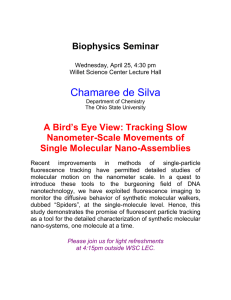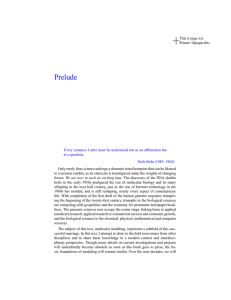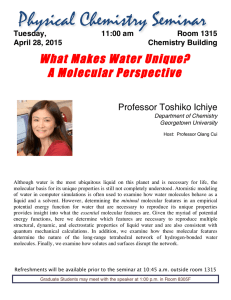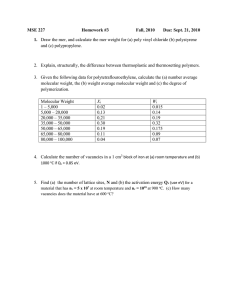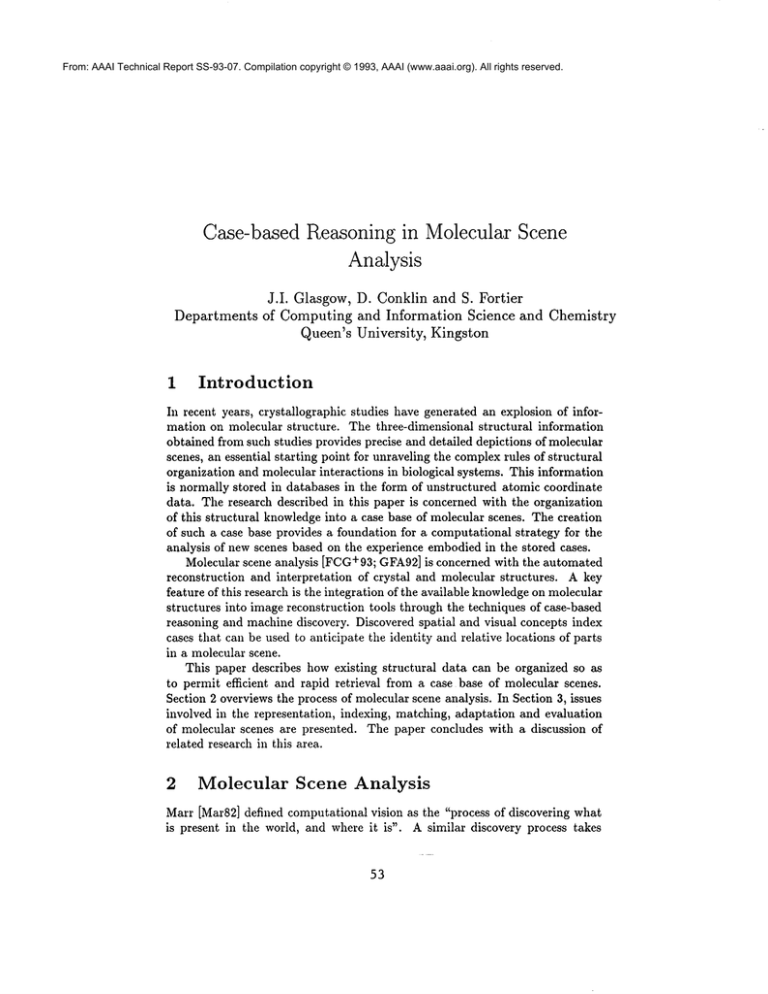
From: AAAI Technical Report SS-93-07. Compilation copyright © 1993, AAAI (www.aaai.org). All rights reserved.
Case-basedReasoningin MolecularScene
Analysis
Departments
1
J.I. Glasgow, D. Conklin and S. Fortier
of Computing and Information Science and Chemistry
Queen’s University, Kingston
Introduction
In recent years, crystallographic studies have generated an explosion of information on molecular structure. The three-dimensional structural information
obtained fromsuch studies provides precise and detailed depictions of molecular
scenes, an essential starting point for unravelingthe complexrules of structural
organization and molecularinteractions in biological systems. This information
is normallystored in databases in the form of unstructured atomic coordinate
data. The research described in this paper is concernedwith the organization
of this structural knowledgeinto a case base of molecularscenes. The creation
of such a case base provides a foundation for a computationalstrategy for the
analysis of newscenes based on the experience embodiedin the stored cases.
Molecular scene analysis [FCG+93;GFA92]is concerned with the automated
reconstruction and interpretation of crystal and molecular structures. A key
feature of this research is the integration of the available knowledge
on molecular
structures into imagereconstruction tools through the techniques of case-based
reasoning and machinediscovery. Discoveredspatial and visual concepts index
cases that can be used to anticipate the identity and relative locations of parts
in a molecularscene.
This paper describes howexisting structural data can be organized so as
to permit efficient and rapid retrieval from a case base of molecular scenes.
Section 2 overviewsthe process of molecularscene analysis. In Section 3, issues
involved in the representation, indexing, matching, adaptation and evaluation
of molecular scenes are presented. The paper concludes with a discussion of
related research in this area.
2
Molecular
Scene Analysis
Marr [Mar82]defined computationalvision as the "process of discovering what
is present in the world, and whereit is". A similar discovery process takes
53
Chemlc=ldata
imase
enhancement
Imase
&
t I ,m ~talJon
ef~mented
’~maste
~
pattern
t
ima8
e
anticipation
nUdpated
motifs
[
matching
l
Po~Ible
J.lerpreLI Uon$
xene
analysis
Phases
Candidate
mase(s)
I
resolve
Figure 1: Processes for Molecular Scene Analysis
place in molecular scene analyses. For example, crystal structure determination, molecular structure classification and prediction, and studies of molecular
recognition processes, can all be viewedas exercises in molecular scene analysis.
Figure 1 illustrates the five independent, but communicating, processes involved in the reconstruction of a three-dimensional molecular scene from experimental diffraction data [FCG+93]. The image anticipation process involves
the retrieval of motifs from a case base according to available chemical and
structural information. In the image enhancement 8¢ segmentation process, an
experimental electron density map(three-dimensional image of a crystal structure) is subjected to standard noise reduction and density modification routines
and segmentedinto distinct blobs/regions that correspond to structural features
of the image. The pattern matching process involves the comparison of unidentified features derived from the segmentation process with anticipated motifs
retrieved from the case base. In the scene analysis process, the possible interpretations are then evaluated using global constraint satisfaction techniques
[Kon93]. Finally, in the resolve process the structural information determined
in the scene analysis process is integrated into the direct methodstools [ttau86]
so as to refine and enhance the emerging image.
54
The process of molecular scene analysis can be expressed as a state space
search, where the initial state is an uninterpreted image and the goal state
is a comprehensive interpreted image of the scene. The state space for this
problem is represented as a set of partially interpreted images, depicted by
symbolic arrays containing symbols denoting the molecular parts in a scene.
These symbols maycorrespond to identified or currently unidentified parts. The
goal of case retrieval in molecular scene analysis is to find a set of previously
determined scenes (cases) which either 1) share visual properties (shape
volume) with an unidentified part in the new image, or 2) share structural
features with the image (i.e. have identified parts in a similar configuration).
Case-based reasoning is applied primarily in the image anticipation process (see
Figure 1) of molecular scene analysis. 1 Here, chemical, structural and visual
information is used in to retrieve cases containing image motifs for potential
pattern matching. Thus, it is important to be able to index the case base
according to the visual and spatial qualities of molecular images.
Crystal structure determination, an example of a molecular scene analysis
exercise, is an iterative process which can be modeled as the resolution of the
three-dimensional image of the atomic arrangement within the crystal. Initially,
the electron density maps to be analyzed are of low resolution. Thus, at this
stage our case-base reasoning is guided primarily by fuzzy shape information
and chemical information (e.g., primary structure). Once some partial structure
information has been hypothesized, this information can be used in the resolve
process to improve the overall image. This is possible because of the Fourier
transform relationship between the data and the image formed [FN89]. Once a
partially interpreted image has been formed (represented by a partially defined
symbolic array), the available three-dimensional structural information can also
be used to anticipate the identity of unknownparts of a scene. The rationale
here is that parts of an image often appear in similar contexts. Thus, a potential
interpretation can be hypothesized based on whether it has occurred previously
in a similar context (defined by the interpreted parts of the scene).
The process of crystal and molecular structure determination usually relies
on an individual crystallographer’s ability to recall, compare and adapt threedimensional structural motifs of previously interpreted scenes. Because of the
chemical constraints placed on molecular images, it is rare that reconstructed
scenes do not contain any parts which have not occurred previously in a similar
spatial configuration. Thus, efficient retrieval of relevant experiences and the
ability to represent, index and pattern match molecular images or motifs, based
on their three-dimensional spatial structure, can greatly aid in molecular scene
analyses.
Rapidly growing crystallographic databases 2 were conceived in the 1960’s
1 However, it may also be beneficial to use case-based reasoning in image evaluation.
2The Cambridge Structural
Database contains over 100,000 organo-carbon compounds and
the Protein Data Bank contains approximately 700 macromolecules; database sizes grow by
more than 10% per year.
55
and 1970’s to contain the explosion of information being generated. For many
years, access to the three-dimensional atomic coordinate data, the vital experimental component of the databases, was gained through information retrieval
and database analysis techniques applied to bibliographic or chemical data. Basic knowledge, in the form of standardized geometric descriptions of molecules
or fragments of molecules, could be generated from retrieved coordinates, but
comparative analysis of large numbers of instances was primarily a manual operation. In recent years, an expanding repertoire of statistical
and numeric
techniques have been introduced to survey, organize and view the geometric
data, in order to recognize patterns and relationships [ADT91]. This paper is
concerned with the further transformation of the ever-growing databases into
case bases that will ultimately provide the foundation to a knowledge-based
approach to molecular scene analysis.
3
Case-based
Reasoning
A crucial component in a computational approach to molecular scene analysis
is the ability to retrieve structural motifs from a case base and adapt these
to classify parts in a partially interpreted image of a novel molecular scene.
Because indexing and matching are based on the three-dimensional structure
of a molecular scene, there are unique problems that must be addressed when
carrying out case-based reasoning in this domain. In the remainder of this
section, we consider the issues of case representation, indexing, matching and
adaptation for the problem domain of molecular scene analysis.
3.1
Representation
of
Cases
In molecular scene analysis we are primarily concerned with questions pertaining
to shape and spatial relationships whose answers rely, in part, on the efficient
recall and analysis of previously determined molecular scenes. Thus, the representation and indexing schemes for case-based reasoning must capture the
fundamental visual and spatial properties of the scenes. Currently, crystallographic databases contain geometric descriptions of the atomic coordinates of a
molecular scene. Although this information is sufficient and complete, it is not
organized for efficient retrieval and pattern matching based on the structural
similarities of scenes. Thus, we incorporate a representational formalism for
computational imagery [GP92], which was tailored to facilitate
the processes
of mental imagery - processes similar to those often used by expert crystallographers in the identification of molecular structures. This frameworkconsists
of knowledgerepresentations and primitive operations that are used to depict,
transform, scan, pattern match and reason with visual and spatial depictions.
To perform case retrieval based on structural similarity of molecular scenes
requires a representation that denotes the meaningful parts of a scene and their
56
v~
W-._
Figure 2: Spatial representation
of molecular image
relevant spatial and topological relations. The scheme for computational imagery includes a spatial knowledgerepresentation that provides an explicit symbolic array depiction of an image. As illustrated in Figure 2, the componentsof
a molecular image are denoted as symbolic components of the array 3, while the
hierarchical structure of a scene is captured using nested arrays. 4 In molecular
scene analysis, such arrays can be reconstructed from the geometric information
stored in the existing databases or from the analysis of experimental electron
density maps.
Crucial to molecular scene analysis are the location, identification and comparison of molecular features, including molecular shapes at varying levels of
resolution. An important step in such analyses is the segmentation of molecules,
or molecular fragments, into shape primitives so as to allow for their rapid and
accurate recognition. Molecular shape information can be extracted from the
three-dimensional electron density maps. The information in these maps, however, is at too detailed a level to allow for efficient pattern matching. Thus, it
is essential to transform this visual representation into one that can capture the
relevant shape information and discard the unnecessary and distracting details.
Weare currently investigating and evaluating several models for the segmentation and representation of molecular fragments as shape primitives. These
include the critical point mappingmethod [Joh77], which uses topological properties of the electron density distribution to segment maps and to represent
shape, and a generalized cylinder model [Bin71], which represents objects as a
hierarchy of segmented parts described as volumetric shapes.
In summary,the contents of a case for a molecular scene includes information
3In Figure 2, the symbolsin the array correspondto aminoacid residues, e.g. alanine
(ALA)and cysteine (CYS)
4Thenested array here denotes the three-dimensionaldepiction of cysteine containing
atomicparts, e.g. nitrogen (N) and carbon(C).
57
for retrieving visual and spatial knowledgeof a molecular scene. This information may be stored explicitly, or it maybe stored in a form that allows for the
generation of depictions of scenes which can then be inspected to retrieve the
relevant information.
3.2
Case
Retrieval
and
Adaptation
The ability to perceive spatial similarities and equivalence is fundamental to
case-based reasoning in molecular scene analysis. Wedefine two images to
be spatially equivalent under a set of relations R if and only if there exists a
mapping f between their parts such that if parts are related by r E R in one
image, then f maps them to parts that are similarly related in the other image.
Such a mapping can be determined through inspection of the symbolic array
depictions.
Spatial equivalence can be used to define the concepts of image similarity for
matching of image representations [CG92]. A measurement of spatial similarity between two images is expressed in terms of the minimal number of image
transformations (amount of adaptation) needed to bring them into equivalence.
Manytypes of adaptations are possible, such as replacing, deleting or moving a
part, or movingparts simultaneously (e.g., rotation). Initial results in studies
molecular similarity suggest that it maybe sufficient to consider only part deletion, provided that the relations R are invariant under rotation and translation.
Assumethat a mapping f is a partial correspondence between two images s and
t that preserves a set of relations R. Then we can define a similarity valuation
for f as the function:
SR(s, ~, f) ~ 2x#/
#,+#t
where #f is the cardinality of the domain of f, and #s and #t are the number
of parts in the two images. The similarity valuation SR(s, t) for two images s
and t can then be defined as the maximumvalue of Sn(s, t, f) over all partial
correspondences f that preserve R. This similarity measure has the property
that structurally equivalent images receive a value of 1; dissimilar images receive
a value of near 0.
Central to our method for case retrieval is the abstract image concept. This
is an image which contains other concepts, rather than instances, as parts. One
image subsumes another if its parts can be mappedinto parts of the other such
that all relations are preserved, and subsumption is inductively preserved by
the mapping. A case base of images is organized by this subsumption relation.
At the leaves of a concept taxonomyare the individual cases; the internal nodes
are image concepts. It has been demonstrated that such a model provides an
efficient modelof structured case retrieval [CG92;Lev92]. It is also semantically
well-founded on the classification model of information retrieval [BGN89].
To construct a concept taxonomy, we have developed a structured concept
formation system called I-MEM(Image MEMory)[CG92], based on the theory
58
description logics [Nebg0], and the concepts of image similarity and subsumption described above. This system accepts a stream of cases, incrementally
building a taxonomy of image concepts. At any stage, an input case may trigger the formation of a new concept, or may simply be placed under the most
specific subsuming concept in the taxonomy. High similarity with an existing
case will trigger concept formation. Preliminary results indicate that I-MEM
constructs hierarchies that facilitate case retrieval [CG92]. Wehave previously
demonstrated that the I-MEMsystem for conceptual clustering can also be used
to successfully discover spatial concepts in the domainof molecular classification [CFGA92].Here the classes correspond to meaningful conceptual groupings
that can be used to index scenes for retrieval in case-based reasoning.
In conclusion, cases of molecular scenes are retrieved based on the visual and
spatial attributes of a scene. Above we have given a brief description of how
spatial indices are represented and created. In indexing and matching a case
with a partially interpreted scene, it is not only important that the images have
similar parts but also that the spatial and topological (bonding) relationships
amongthese parts are preserved. Specialized representations and techniques for
spatial analogy and subsumption have been developed to address these issues.
3.3
Image
Reconstruction
and
Evaluation
Once the relevant molecular scenes have been retrieved and adapted, they can
then be used to predict the identity of a previously unknownpart in a molecular
scene. In the adaptation step, previously determined scenes are transformed,
through functions such as parts deletion or rotation, to come into correspondence with the current scene. Although it is assumed that the scene being
analyzed is novel, it is also well knownthat the structural building blocks of
molecules, and particularly of proteins, occur in familiar patterns; a scene can
usually be decomposed into meaningful parts that have often been previously
experienced in similar configurations and with similar shapes. Thus, a retrieved
case can be used to predict the identity of a part based on its visual qualities
and/or its context within a neighborhood of interpreted parts. As discussed in
Section 2, the prediction of these parts can then be used to resolve the current
image which can then be reanalyzed to interpret more of the structure.
Interpretation of parts within a molecular image can be achieved based on the
retrieval of a single similar case or on a concept that has been formed using the
machine learning techniques described earlier. The retrieval of such experiences
can result in one or more of the previously uninterpreted parts of an image being
instantiated (i.e., the identity of one or more parts are hypothesized).
Once an image representation has been transformed (identity of parts added)
based on scenes retrieved from the case base, image evaluation can be phrased
as a constraint satisfaction problem. In particular,
an emerging image must
adhere to the knowncrystallographic and chemical constraints imposed by the
input data. These include hard constraints, such as chemical constitution, as
59
well as soft constraints, such as those involved in molecular interactions.
4
Concluding
Discussion
It is understood that there exists a one-to-one correspondence between the threedimensional structure of a protein and its amino acid sequence. Considerable
research efforts are being devoted to the problem of predicting a protein’s structure from its sequence (e.g. [HS91; Kin87; QS88; RW88;ZW89]). Although
taking such aa approach maybe tractable in the future, it is generally accepted
that there are currently too few examples to accurately predict structure from
the sequence alone [RW88]. Wepropose an approach to protein structure determination that uses case-based reasoning to anticipate three-dimensional substructures within a molecular scene. Experimental data from crystallographic
experiments can then be used to validate the hypothesized parts within the
scene. Thus, molecular scene analysis can be phrased as an iterative process
using a top-down approach to anticipate molecular parts, working in tandem
with a bottom up visual analysis of the image present in the electron density
real).
Currently, a great deal of structural information is available, yet not generally exploited, at the outset of a structure determination exercise [ABS87]. Its
systematic use is not trivial, in part because the information is available only
in the form of coordinate data, defined in terms of an external reference frame.
The transformation of the data into cases which can be indexed and matched
based on structural similarity is of fundamental importance to the problem of
molecular scene analysis.
Similar to PROTOS[Bar89], which diagnoses hearing disorders, our approach to scene analysis applies previous experiences to the task of classification.
Given a partially interpreted molecular image, we find potential classifications
for structural subimages and use these to predict and evaluate the identity of
unknownparts of the scene. The classification problem for molecular scene analysis, however, has someunique features. In particular, it requires the representation and comparison of three-dimensional image representations of molecular
structures. To accommodatethis, we incorporate specialized representation and
machine learning formalisms to store and classify molecular knowledge.
The focus of this paper has been on the use of case-based reasoning in the
domain of molecular biology, an area recognized as providing opportunities for
integrating a variety of artificial intelligence techniques [Hun92]. The massive
amounts of available crystallographic data implies the need for efficient representation, indexing and retrieval techniques applied to chemical and spatial
information. Thus, it is of great interest to our project to investigate and evaluate approaches to case-based reasoning and information retrieval.
6O
References
[ABS8
]
F.H. Allen, G. Bergerhoff, and R. Sievers, editors. Crystallographic
Databases. IUCr, Chester, UK, 1987.
[ADT91]
F.H. Allen, M.$. Doyle, and R. Taylor. Automated conformational
analysis from crystallographic data, 3. Three-dimensional structural
database system: implementation and practical examples. Acta
Crystallographica, B47:50-61, 1991.
[BarS9]
E.R. Bareiss. Exemplar-Based Knoweldge Acquisition: A Unified
Approach to Concept Representation, Classification, and Learning.
Academic Press, Boston, MA, 1989.
[BGN89]
H. W. Beck, S. K. Gala, and S. B. Navathe. Classification
as a
query processing technique in the CANDIDE
semantic data model.
In Proc. IEEE International Data Engineering Conference, pages
572-581, 1989.
[Bin71]
T.O. Binford. Visual perception by a computer. In Proceedings of
IEEE Conference on Systems and Control, Miami, Florida, 1971.
[CFGA92] D. Conklin, S. Fortier, J. Glasgow,and F. Allen. Discovery of spatial
concepts in crystallographic databases. In Proceedings of the Machine
Discovery Workshop, pages 111-116, Aberdeen UK, 1992.
[CG92]
D. Conklin and J.I. Glasgow. Spatial analogy and subsumption. In
Sleeman and Edwards, editors, Machine Learning: Proceedings of
the Ninth Inlernational Conference ML(92), pages 111-116. Morgan
Kaufmann, 1992.
[FCG+93] S. Fortier, I. Castleden, J. Glasgow, D. Conklin, C. Walmsley,
L. Leherte, and F. Allen. Molecular scene analysis: The integration of direct methodsand artificial intelligence strategies for solving
protein crystal structures. Acta Crystallographica, D1, 1993.
[FN89]
S. Fortier and G.D. Nigam. On the probabilistic
theory of isomorphous data sets: general joint distributions for the SIR, SAS, and
partial/complete structure cases. Acta Crystallographica, A45:247254, 1989.
[GFA92]
J.I. Glasgow, S. Fortier, and F.H. Allen. Molecular scene analysis:
crystal structure determination through imagery. In L. Hunter, editor, Artificial Inlelligence and Molecular Biology. AAAIPress, 1992.
[GP92]
J.I. Glasgow and D. Papadias. Computational imagery. Cognitive
Science, 16(3):355-394, 1992.
61
[Hau86]
H. Hauptman. The direct methods of X-ray crystallography.
233:178-183, 1986.
[HS91]
L. Hunter and D.J. States. Applying Bayesian classification to protein structure. In Proceedings of the Seventh IEEE Conference on
Artificial Intelligence Applications, Miami, Florida, 1991.
[Hun92]
L. Hunter. Artificial intelligence and molecular biology. In Proceedings of the Tenth National Conference on Artificial Intelligence,
pages 866-868, 1992.
[Joh77]
C.K. Johnson. Peaks, passes, pales and pits: a tour through the
critical points of interest in density maps. In Proceedings of the
American Crystallographic Association Meeting, Asilomar, California, 1977. Abstract JQ6.
[Kin87]
It. D. King. An inductive learning approach to the problem of predicting a protein’s secondary structure from its amino acid sequence.
In Proc. EWSL’87, 1987.
[Kon93]
K. Konstantinos. Evaluation of partially interpreted images. Master’s thesis, Queen’s University, Kingston, Canada, 1993. to appear.
[Lev92]
It. Levinson. Pattern associativity and the retrieval of semantic networks. Computers Ma~h. Applic., 23(6):573-600, 1992.
[MarS2]
D. Marr. Vision. W.H. Freeman and Company: San Francisco,
[Neb90]
B. Nebel. Reasoning and revision in hybrid representation systems.
Springer-Verlag, 1990.
[QS88]
N. Qian and T.S. Sejnowski. Predicting the secondary structure of
globular proteins using neural network models. Molecular Biology,
202:865-884, 1988.
[aws8]
M.J. Roomanand S.J. Wodak. Identification
of predictive sequence
motifs limited by protein structure data base size. Nature, 335:45 49, 1988.
[zws9]
X. Zhang and D. Waltz. Protein structure prediction using memory
based reasoning: A case study of data exploration. In Proceedings of
a Workshop on Case-Based Reasoning, pages 351-355, San Mateo,
California, 1989. Morgan KaufmannPublishers, Inc.
62
Science,
1982.



